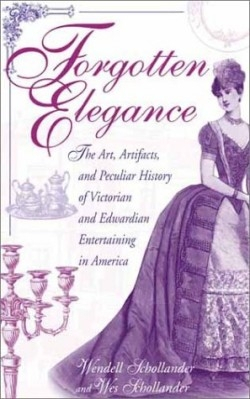Forgotten Elegance
The Art Artifacts and Peculiar History of Victorian and Edwardian Entertaining in America
At a Victorian dinner party, woe betide the fool who used his pickle fork to eat his duck—or his strawberry fork to eat asparagus.
By the time that era’s famous fussiness made its way to the table, any given meal might require as many as twenty-five different forks, discernible from one another by way of splayed tines here, a cutout there. Such marvels of excess and culinary overkill fill this book, compiled painstakingly but not without bemusement. Cataloguing meal’s button-poppingly huge menus and exposing the demands made on hosts and diners at a time when rules applied to virtually everything, the father-and-son authors provide a wealth of details that make modern eating appear almost Neanderthal in comparison. Gloves were to be worn during certain parts of tea parties but removed at others; hot chocolate could only be served from hot-chocolate pots.
“A finger bowl and a glass plate were put on a china fruit plate with a doily between the finger bowl and the glass plate,” the authors explain in one typically precise passage on table protocol. “A dessert fork and spoon were put on the glass plate.” They go on to tell where, exactly, the diner must place the finger bowl and what must be eaten from the plate.
Schollander père is an attorney, who has collected Victorian silver, porcelain, and etiquette books for more than twenty-five years. Schollander fils grew up discussing the proper placement of forks at formal dinners, then took off to go backpacking and do missionary and conservation work. He is currently enrolled in law school.
The authors have rendered the retinue of cutlery and cold and hot courses with great exactitude, which sometimes slows the text down to a plod. But its depth and breadth make up for any weakness in its style. For the conscientious reader, this book is a history lesson bound to inspire countless mealtime conversations about why the salad has been served first and whether or not the host should wear a hat. Hindsight lends a certain poignancy to any history lesson. Combined with the Schollanders’ prodigious research, it affords Forgotten Elegance a sympathetic tenderness that would have been appreciated by those harried butlers, overworked cooks, and nervous party guests of yore.
Reviewed by
Anneli Rufus
Disclosure: This article is not an endorsement, but a review. The publisher of this book provided free copies of the book to have their book reviewed by a professional reviewer. No fee was paid by the publisher for this review. Foreword Reviews only recommends books that we love. Foreword Magazine, Inc. is disclosing this in accordance with the Federal Trade Commission’s 16 CFR, Part 255.

